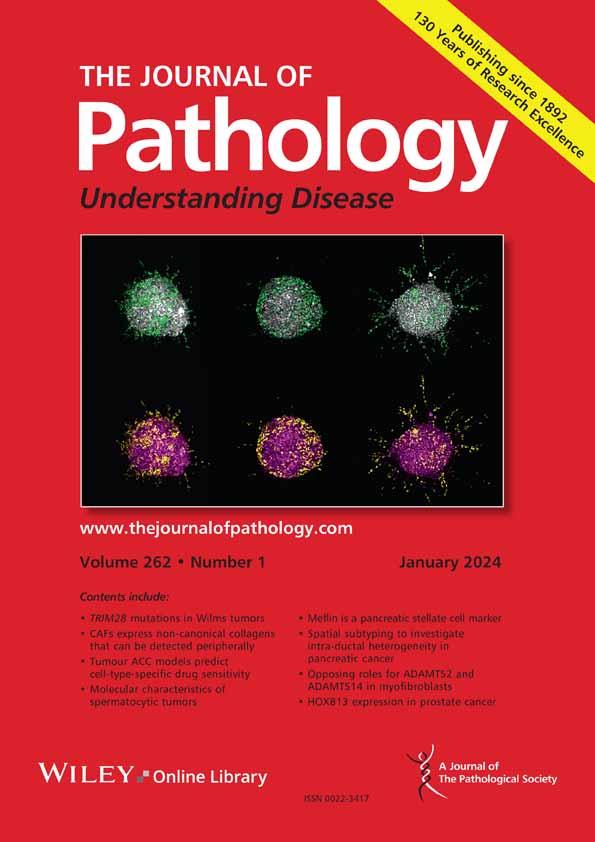Pei-Hang Lee, Shih-Chiang Huang, Jen-Chieh Lee, Sung-Chou Li, Jen-Wei Tsai, Yi-Ming Chang, Yu-Chien Kao, Wen-Lang Fan, Ching-Di Chang, Hui-Chun Chen, Chih-Hao Li, Chia-Fa Hu, Ting-Ting Liu, Pao-Shu Wu, Mann-Hua Nam, Shih-Chen Yu, Jui-Chu Wang, Hsuan-Ying Huang
求助PDF
{"title":"在胃肠道神经鞘瘤中,框架内插入的SOX10高度富集,具有独特的转录组特征。","authors":"Pei-Hang Lee, Shih-Chiang Huang, Jen-Chieh Lee, Sung-Chou Li, Jen-Wei Tsai, Yi-Ming Chang, Yu-Chien Kao, Wen-Lang Fan, Ching-Di Chang, Hui-Chun Chen, Chih-Hao Li, Chia-Fa Hu, Ting-Ting Liu, Pao-Shu Wu, Mann-Hua Nam, Shih-Chen Yu, Jui-Chu Wang, Hsuan-Ying Huang","doi":"10.1002/path.6426","DOIUrl":null,"url":null,"abstract":"<p>Gastrointestinal schwannomas are molecularly and histologically distinct from their non-gastrointestinal counterparts, lacking <i>NF2</i> alterations, although the primary drivers of these tumors are barely understood. A recent study has identified <i>SOX10</i> in-frame insertions in schwannomas, particularly in intracranial non-vestibular lesions, whereas their role in gastrointestinal schwannomas remains unexplored. Whole exome sequencing of 15 gastrointestinal and two non-gastrointestinal schwannomas revealed recurrent <i>SOX10</i> in-frame insertions in 14 gastrointestinal cases (93%) without other nerve sheath tumor-related alterations, such as <i>NF2</i> mutations or <i>SH3PXD2A</i>::<i>HTRA1</i> fusions (~14% in non-gastrointestinal cases). The prevalence, mutation spectrum, and specificity of <i>SOX10</i> insertions were validated using Sanger sequencing in a large cohort comprising 61 gastrointestinal and 98 non-gastrointestinal schwannomas, as well as 110 non-schwannomatous mesenchymal and melanocytic neoplasms. <i>SOX10</i> insertions, occurring within or near the high mobility group box domain, were significantly enriched in gastrointestinal schwannomas (91.8%) compared with non-gastrointestinal cases (5.1%). The most common insertion, p.Y173_Q174insKY, was present in 86.9% of gastrointestinal schwannomas but absent in non-gastrointestinal cases. Another recurrent insertion, p.P175_R176insKYQP, was rare and exclusively found in non-gastrointestinal schwannomas (3/98), while all non-schwannomatous controls were <i>SOX10</i>-normal. <i>SOX10</i>-inserted schwannomas exhibited histologic features characteristic of gastrointestinal schwannomas, including a microtrabecular arrangement of Schwann cells, peripheral lymphoid cuffs, and a lack of encapsulation. Both <i>SOX10</i>-inserted and <i>SOX10</i>-normal schwannomas demonstrated diffuse SOX10 immunoreactivity. The <i>SOX10</i>-inserted group was significantly associated with gastrointestinal locations (<i>p</i> < 0.001), older patients (<i>p</i> < 0.001), fusion negativity (<i>p</i> < 0.001), and larger tumor size (<i>p</i> = 0.013). Gene expression profiling of 44 cases revealed distinct transcriptomic profiles between primarily <i>SOX10</i>-inserted and <i>SOX10</i>-normal groups, with the latter group being classifiable into fusion-poor and fusion-enriched sub-clusters. This study highlights the genetic heterogeneity of schwannomas and suggests that <i>SOX10</i> insertions play a pivotal role in the tumorigenesis of gastrointestinal schwannomas, distinctly separating them from non-gastrointestinal counterparts and contributing to their unique molecular profile. © 2025 The Pathological Society of Great Britain and Ireland.</p>","PeriodicalId":232,"journal":{"name":"The Journal of Pathology","volume":"266 3","pages":"268-279"},"PeriodicalIF":5.2000,"publicationDate":"2025-04-24","publicationTypes":"Journal Article","fieldsOfStudy":null,"isOpenAccess":false,"openAccessPdf":"","citationCount":"0","resultStr":"{\"title\":\"In-frame insertions of SOX10 are highly enriched and characterize a distinct transcriptomic profile in gastrointestinal schwannomas\",\"authors\":\"Pei-Hang Lee, Shih-Chiang Huang, Jen-Chieh Lee, Sung-Chou Li, Jen-Wei Tsai, Yi-Ming Chang, Yu-Chien Kao, Wen-Lang Fan, Ching-Di Chang, Hui-Chun Chen, Chih-Hao Li, Chia-Fa Hu, Ting-Ting Liu, Pao-Shu Wu, Mann-Hua Nam, Shih-Chen Yu, Jui-Chu Wang, Hsuan-Ying Huang\",\"doi\":\"10.1002/path.6426\",\"DOIUrl\":null,\"url\":null,\"abstract\":\"<p>Gastrointestinal schwannomas are molecularly and histologically distinct from their non-gastrointestinal counterparts, lacking <i>NF2</i> alterations, although the primary drivers of these tumors are barely understood. A recent study has identified <i>SOX10</i> in-frame insertions in schwannomas, particularly in intracranial non-vestibular lesions, whereas their role in gastrointestinal schwannomas remains unexplored. Whole exome sequencing of 15 gastrointestinal and two non-gastrointestinal schwannomas revealed recurrent <i>SOX10</i> in-frame insertions in 14 gastrointestinal cases (93%) without other nerve sheath tumor-related alterations, such as <i>NF2</i> mutations or <i>SH3PXD2A</i>::<i>HTRA1</i> fusions (~14% in non-gastrointestinal cases). The prevalence, mutation spectrum, and specificity of <i>SOX10</i> insertions were validated using Sanger sequencing in a large cohort comprising 61 gastrointestinal and 98 non-gastrointestinal schwannomas, as well as 110 non-schwannomatous mesenchymal and melanocytic neoplasms. <i>SOX10</i> insertions, occurring within or near the high mobility group box domain, were significantly enriched in gastrointestinal schwannomas (91.8%) compared with non-gastrointestinal cases (5.1%). The most common insertion, p.Y173_Q174insKY, was present in 86.9% of gastrointestinal schwannomas but absent in non-gastrointestinal cases. Another recurrent insertion, p.P175_R176insKYQP, was rare and exclusively found in non-gastrointestinal schwannomas (3/98), while all non-schwannomatous controls were <i>SOX10</i>-normal. <i>SOX10</i>-inserted schwannomas exhibited histologic features characteristic of gastrointestinal schwannomas, including a microtrabecular arrangement of Schwann cells, peripheral lymphoid cuffs, and a lack of encapsulation. Both <i>SOX10</i>-inserted and <i>SOX10</i>-normal schwannomas demonstrated diffuse SOX10 immunoreactivity. The <i>SOX10</i>-inserted group was significantly associated with gastrointestinal locations (<i>p</i> < 0.001), older patients (<i>p</i> < 0.001), fusion negativity (<i>p</i> < 0.001), and larger tumor size (<i>p</i> = 0.013). Gene expression profiling of 44 cases revealed distinct transcriptomic profiles between primarily <i>SOX10</i>-inserted and <i>SOX10</i>-normal groups, with the latter group being classifiable into fusion-poor and fusion-enriched sub-clusters. This study highlights the genetic heterogeneity of schwannomas and suggests that <i>SOX10</i> insertions play a pivotal role in the tumorigenesis of gastrointestinal schwannomas, distinctly separating them from non-gastrointestinal counterparts and contributing to their unique molecular profile. © 2025 The Pathological Society of Great Britain and Ireland.</p>\",\"PeriodicalId\":232,\"journal\":{\"name\":\"The Journal of Pathology\",\"volume\":\"266 3\",\"pages\":\"268-279\"},\"PeriodicalIF\":5.2000,\"publicationDate\":\"2025-04-24\",\"publicationTypes\":\"Journal Article\",\"fieldsOfStudy\":null,\"isOpenAccess\":false,\"openAccessPdf\":\"\",\"citationCount\":\"0\",\"resultStr\":null,\"platform\":\"Semanticscholar\",\"paperid\":null,\"PeriodicalName\":\"The Journal of Pathology\",\"FirstCategoryId\":\"3\",\"ListUrlMain\":\"https://pathsocjournals.onlinelibrary.wiley.com/doi/10.1002/path.6426\",\"RegionNum\":2,\"RegionCategory\":\"医学\",\"ArticlePicture\":[],\"TitleCN\":null,\"AbstractTextCN\":null,\"PMCID\":null,\"EPubDate\":\"\",\"PubModel\":\"\",\"JCR\":\"Q1\",\"JCRName\":\"ONCOLOGY\",\"Score\":null,\"Total\":0}","platform":"Semanticscholar","paperid":null,"PeriodicalName":"The Journal of Pathology","FirstCategoryId":"3","ListUrlMain":"https://pathsocjournals.onlinelibrary.wiley.com/doi/10.1002/path.6426","RegionNum":2,"RegionCategory":"医学","ArticlePicture":[],"TitleCN":null,"AbstractTextCN":null,"PMCID":null,"EPubDate":"","PubModel":"","JCR":"Q1","JCRName":"ONCOLOGY","Score":null,"Total":0}
引用次数: 0
引用
批量引用




 求助内容:
求助内容: 应助结果提醒方式:
应助结果提醒方式:


